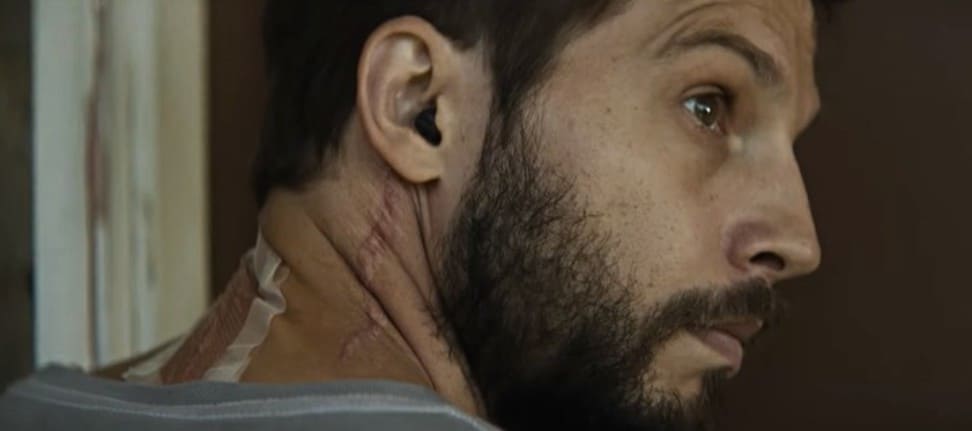A low-budget film by Lee Whannell, who became famous for “Astral-3” and “Saw”, unexpectedly aroused genuine interest among critics and viewers, allowing a fresh look at the sore question of the relationship between man and his creation – the computer. Gadgetomania is cursed by all and sundry – from priests to doctors, while still painfully dependent on new technologies.
Will we give up the opportunity to self-upgrade, improve ourselves? Unlikely. Will we give up the opportunity to save our lives and regain lost health with the help of a computer chip? Never.

A car mechanic in the world of cyberpunk
Gray is used to doing everything with his own hands, although he lives in a “smart house”, which is ready not only to do everything, but also to think for its owner. He restores old cars and is not friendly with modern technology. Good-naturedly laughing at his “advanced” wife, he even refuses to get into her fancy self-driving “supercar”. He is a representative of an “endangered species”, one of the few people left in the world who do not try to improve themselves with the help of implanted chips and implants.
Gray does not trust “smart” cars and turns out to be right – a robotic car “hacked” by someone at a distance changes its usual route and brings them with his wife to a criminal area, where the hero suddenly loses everything – his beloved wife, health, mobility, the ability to even lift a finger. Now the former mechanic has become completely dependent on automatic machines that readily serve him, but are unable to heal either mental or physical injuries.
And now he has a sudden opportunity to get on his feet in the literal and figurative sense: his client, a computer genius and a collector of old cars named Aaron, offers to implant his experimental development – the Stem chip – in Gray. For a good cause, of course! And the former implant hater breaks down. Not only in order to restore mobility to your body, but also in order to find the murderers of your wife.

Voice in the head
We often talk to our gadgets as if they were alive, we refer to them as to animate persons, and we receive from them standard, but quite intelligible messages: “the process is in progress, please wait”, “refresh the page”, “reboot the device”. “Alice” and “Siri” answer questions and even joke and flirt. Stem begins his conversation with Gray in an insinuating and humble manner, asking permission for every action.
But with every second the voice in the hero’s head becomes harder, more and more intrusive. This self-willed “puppeteer”, implanted into the human body, gradually captures all “control levers”. “Stem” manifests itself not as a machine, not as a computer, but as a person. He jokes, provokes, argues, orders, kills. He goes against both his master – Gray, and against his creator – Aaron.
Does this mean that a computer is smarter than a person? No. He is the way the human genius created him. The trouble is that blindly trusting technology, a person voluntarily renounces his leading role. He makes himself dependent on his own inventions, not thinking about the consequences. Once he has given up his principles, Gray can no longer stop. Stem literally does what it wants, manipulating both Aaron and Gray.

Gray is disgusted with the cruelty of “Stem”, he does not want to take revenge on the murderers of his wife, he wants to get to the bottom of it. But the cynical “voice in my head” understands everything in its own way and does everything in its own way, mercilessly removing both criminals and police from the road. Gray is no longer able to resist him, unable to refuse his insidious “help”: the former master became a slave.
This is not to say that “Stem” turns Gray into a monster. Coming to his senses, Gray tries to argue, resist. However, the capabilities that his body began to possess thanks to the chip are deceptively attractive, and he completely surrenders himself to the “hands” of a computer manipulator.
To take revenge or not to take revenge
“Upgrade” raises another question – about the futility of revenge. The hero finds answers to his questions, finds both the murderers of his wife and the customer, but this does not bring him relief for a second. On the contrary, it is the attempt to take revenge that drives the hero into a trap set in advance.
If Gray used “Stem” only as a means to restore health, did not listen to the prompts of the “voice in his head” playing on emotions – perhaps he would have remained the master of his fate, mind and body.

Virtual Brain Trap
“How can you exchange the real world for a virtual one?” – the hero is perplexed when he finds himself in the company of virtual reality lovers immersed in computer dreams. At that time, he still does not realize what trap he has fallen into.
It all starts small – with dreams. Stem, as if groping, offers Gray an “alternate reality” dream where his wife is alive. Seeing the violent reaction of his “ward”, he finds an opportunity to completely take over his consciousness. To do this, you just need to immerse Gray’s brain in such a saving dream, fill it with convincing images, turn off consciousness. If it works with PC game fans, why shouldn’t it work with a stubborn auto mechanic?
So Gray breaks down again. He plunges into virtual reality, carefully created by Stem, completely leaving the real world. All that remains is the body, which is completely owned by the computer chip. It turns out “Ghost in the Shell” on the contrary – not a human mind implanted in an artificial shell, but an artificial mind that controls the human body.
Whether Gray will be able to return is unknown. The film’s producer, Jason Bloom, has promised a sequel. This means that the struggle between the “doll” and the “puppeteer” is not over.







